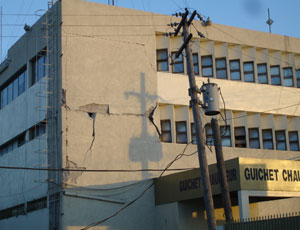Poor quality, often homemade concrete led to widespread building damage in Port-au-Prince following last month’s earthquake in Haiti, says Ken Hover, an engineering professor at Cornell University who had recently returned from the devastated city.
Hover made his remarks Feb. 3 at the World of Concrete tradeshow in Las Vegas. He had performed structural assessments for two university-backed Port-au-Prince health clinics from Jan. 20-25.
The clinics consisted of 15 separate structures. Hover says he used California's post-earthquake investigation guide as a reference for his assessments.
“Haitian medium-duty buildings and residences typically have concrete columns at the corners with concrete blocks in between” Hover says. “There is usually very little reinforcement, and virtually no mortar between joints. Blocks are often loosely stacked atop one another and finished with a smoothed concrete exterior.”
Haiti lacks steel manufacturing and fabricating facilities and long ago logged most of its forest for fuel. Most of the country’s concrete is either homemade or comes from the neighboring Dominican Republic where Monterrey, Mexico-based Cemex S.A.B. de C.V. has established a major operation.
Homemade concrete had been widely used in Haiti.
Many locals purchase cement piecemeal from sidewalk vendors, acquiring sand and mix separately, and dilute the mix to create greater quantities. Prior to the earthquake, it wasn't uncommon to see partially built structures.
“You slowly work on your store, business or home as money permits,” Hover says. “Cement is so expensive that Haitians will try to make as many blocks as possible.”
Soft, flaky and loose soil conditions also contributed to Haiti’s widespread building damage since most buildings lack sufficient foundation systems; piles and spread footings are virtually nonexistent, Hover says.
“Haiti has not had a devastating earthquake in over 200 years. So people were not thinking seismic design; they were thinking of what was an economic way to build a building,” Hover says. “There is no semblance of an urban renewal plan yet. What I saw was people looking through the ruins for unbroken concrete blocks to reuse.”



Post a comment to this article
Report Abusive Comment